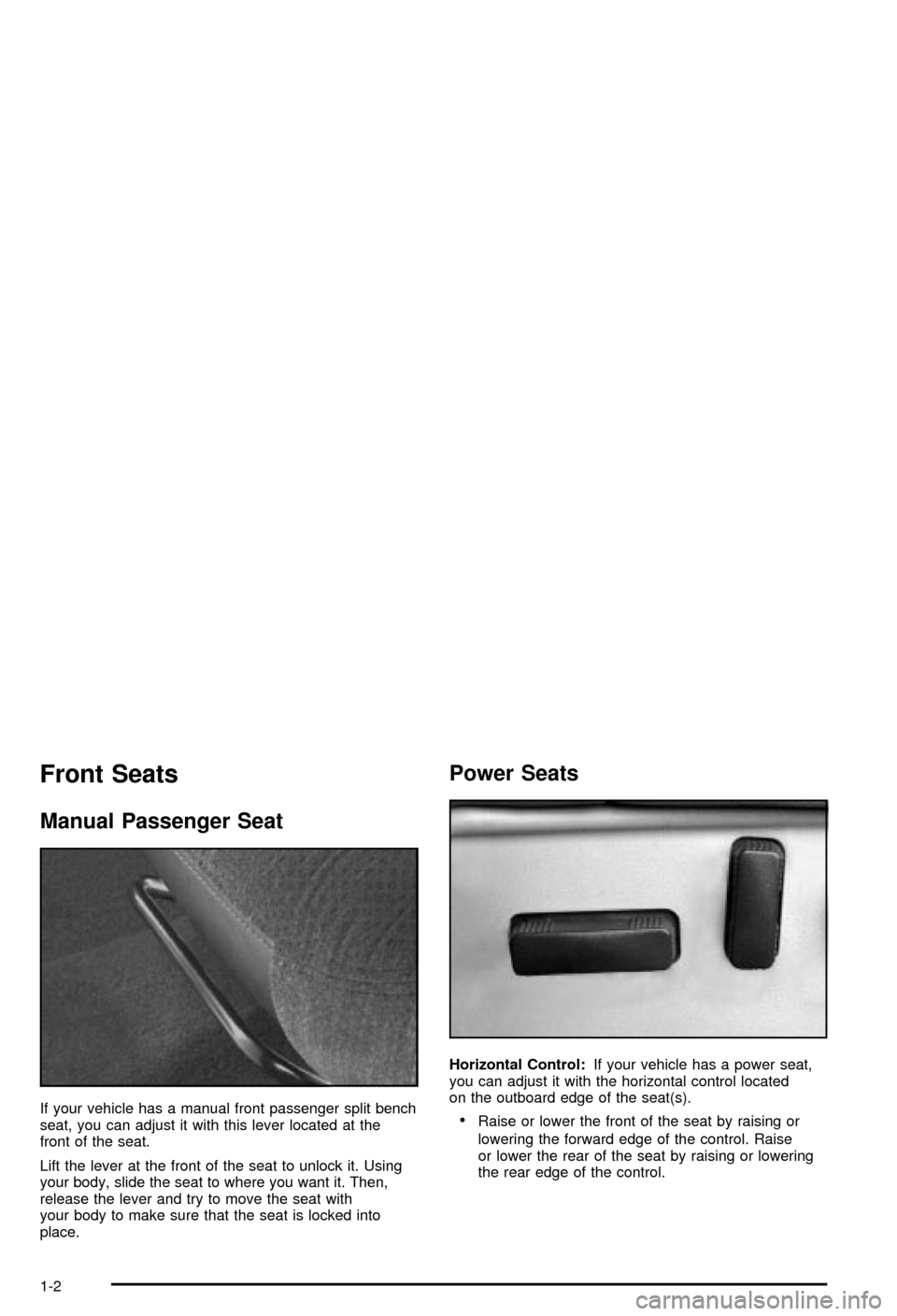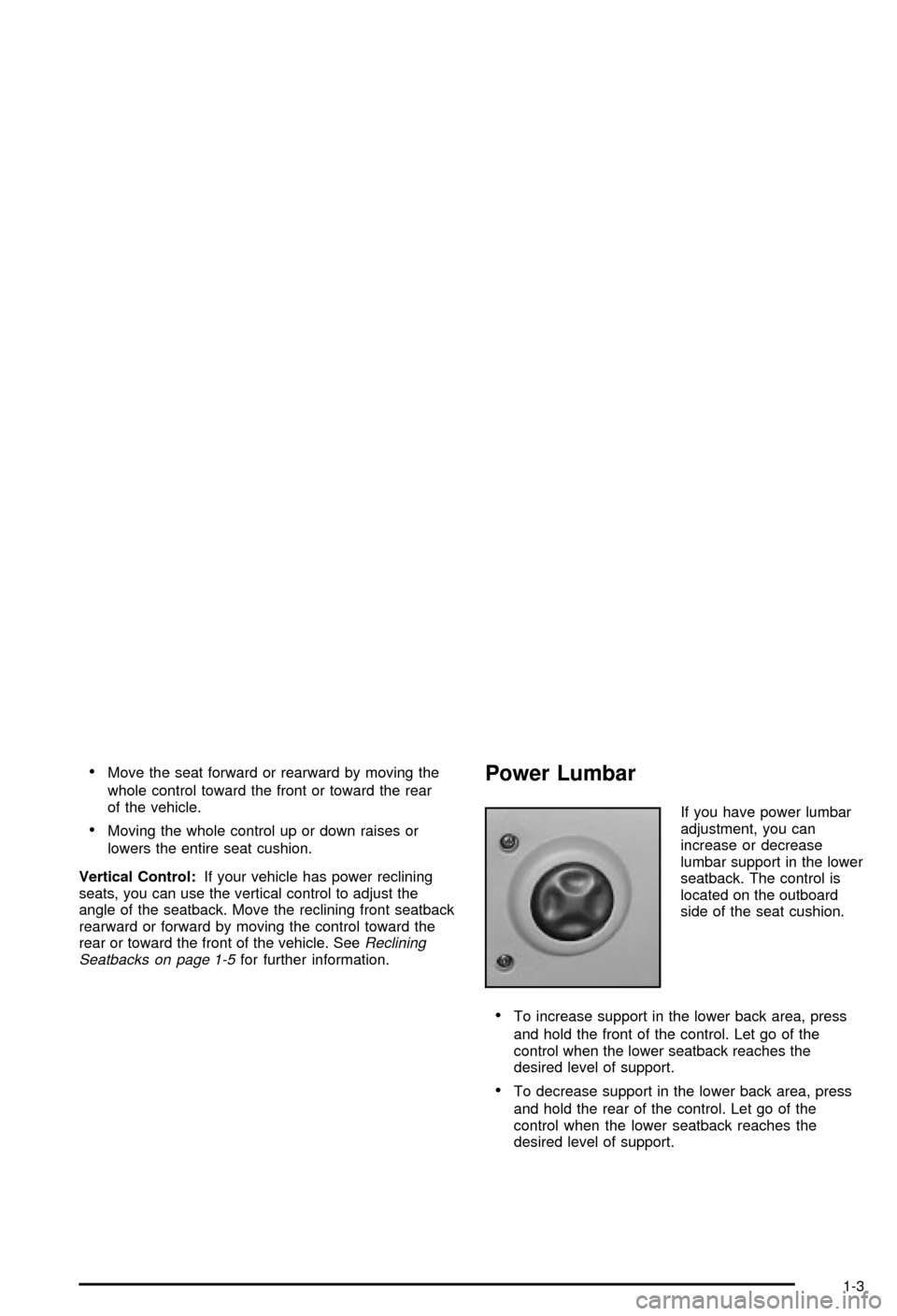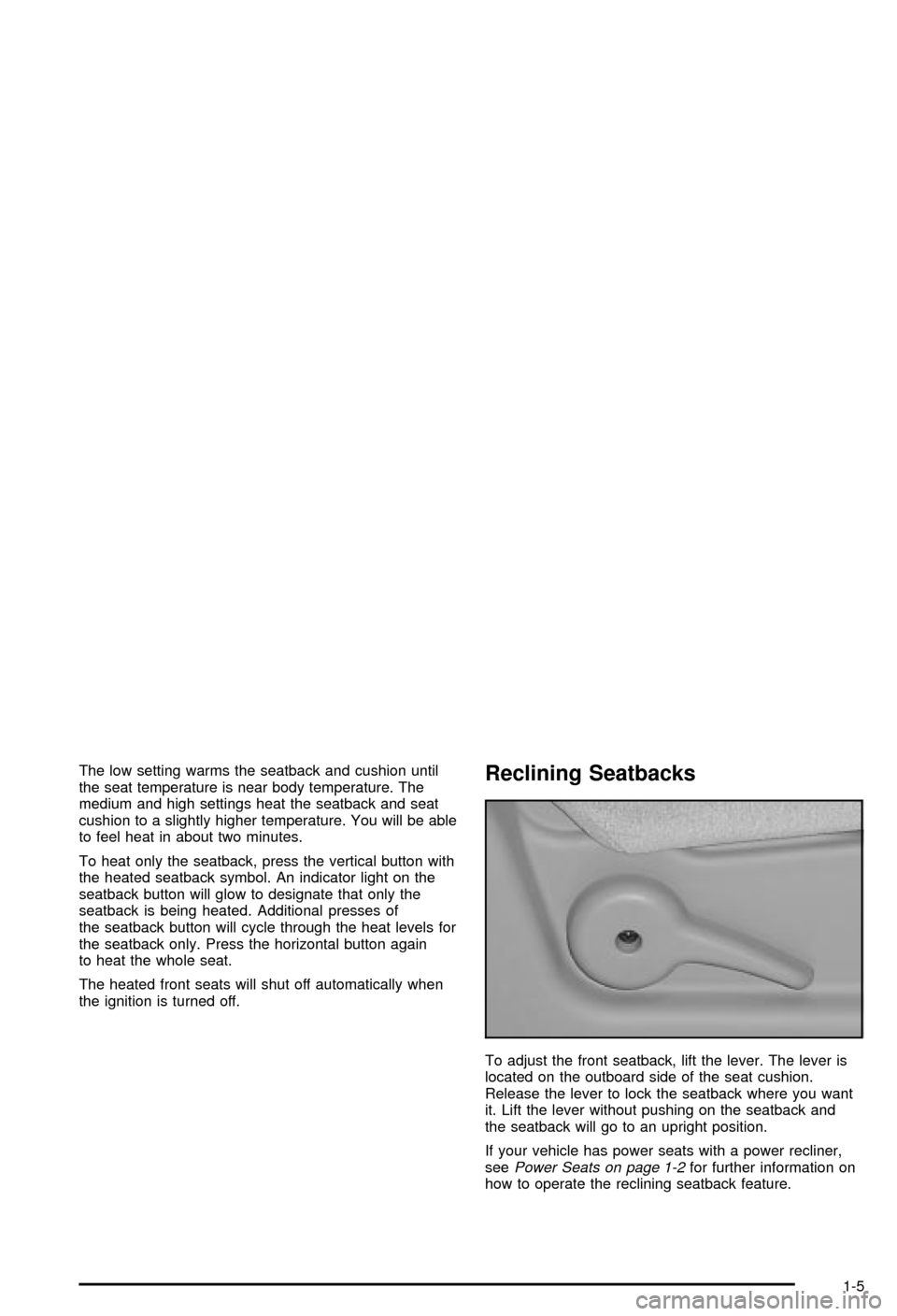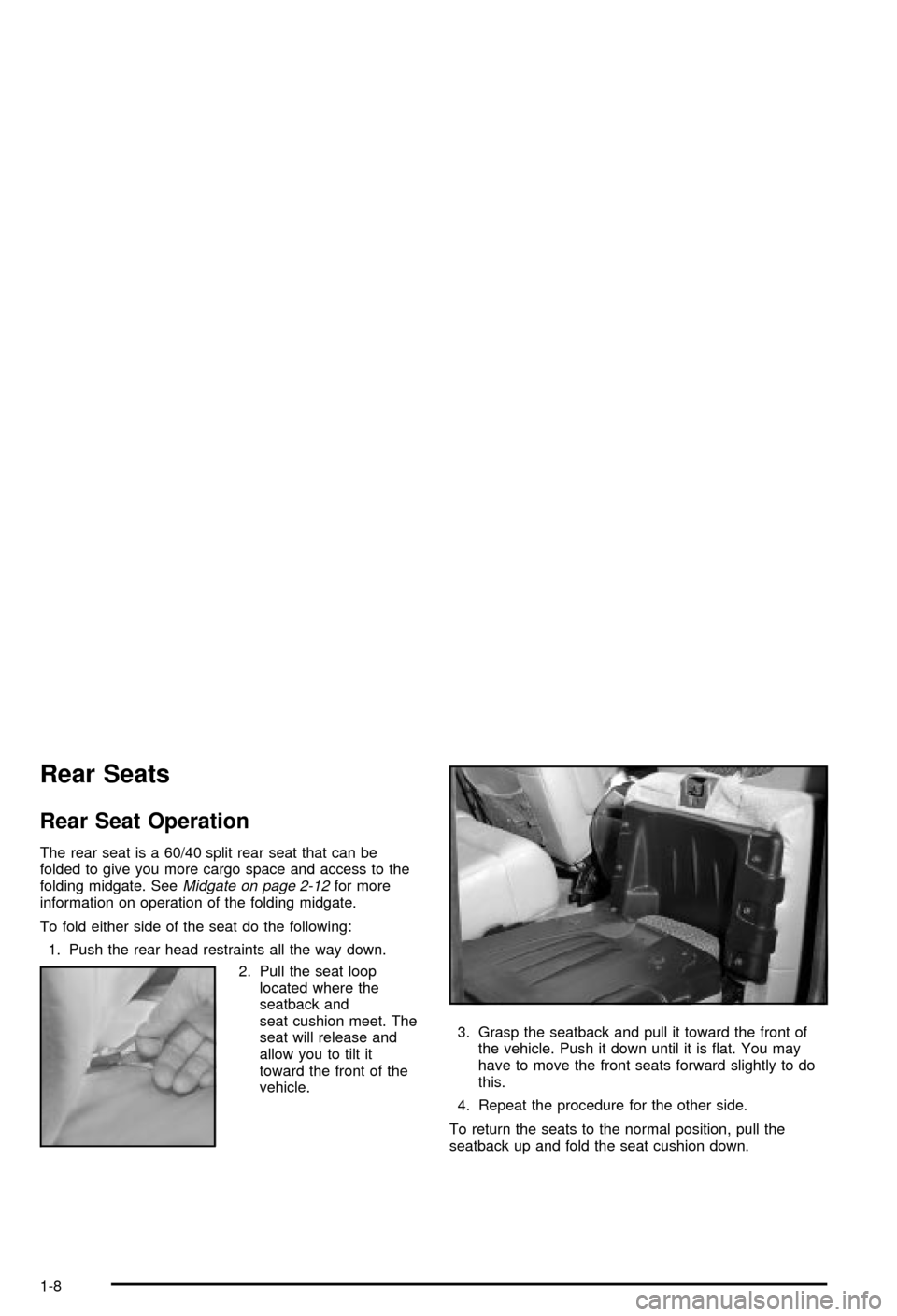2003 CHEVROLET AVALANCHE seats
[x] Cancel search: seatsPage 1 of 492

Seats and Restraint Systems........................... 1-1
Front Seats
............................................... 1-2
Rear Seats
............................................... 1-8
Safety Belts
.............................................1-10
Child Restraints
.......................................1-32
Air Bag Systems
......................................1-52
Restraint System Check
............................1-67
Features and Controls..................................... 2-1
Keys
........................................................ 2-3
Doors and Locks
....................................... 2-7
Windows
.................................................2-23
Theft-Deterrent Systems
............................2-25
Starting and Operating Your Vehicle
...........2-27
Mirrors
....................................................2-46
OnStar
žSystem
......................................2-53
HomeLinkžTransmitter
.............................2-55
Storage Areas
.........................................2-59
Sunroof
..................................................2-84
Vehicle Personalization
.............................2-85
Instrument Panel............................................. 3-1
Instrument Panel Overview
.......................... 3-4
Climate Controls
......................................3-20
Warning Lights, Gages and Indicators
.........3-30
Driver Information Center (DIC)
..................3-46
Audio System(s)
.......................................3-64Driving Your Vehicle....................................... 4-1
Your Driving, the Road, and Your Vehicle
..... 4-2
Towing
...................................................4-48
Service and Appearance Care.......................... 5-1
Service
..................................................... 5-3
Fuel
......................................................... 5-5
Checking Things Under the Hood
...............5-10
Rear Axle
...............................................5-49
Four-Wheel Drive
.....................................5-50
Front Axle
...............................................5-51
Bulb Replacement
....................................5-52
Windshield Wiper Blade Replacement
.........5-60
Tires
......................................................5-61
Appearance Care
.....................................5-88
Vehicle Identi®cation
.................................5-96
Electrical System
......................................5-96
Capacities and Speci®cations
...................5-106
Normal Maintenance Replacement Parts
....5-108
Maintenance Schedule..................................... 6-1
Maintenance Schedule
................................ 6-2
Customer Assistance Information.................... 7-1
Customer Assistance Information
.................. 7-2
Reporting Safety Defects
...........................7-10
Index................................................................ 1
2003 Chevrolet Avalanche Owner ManualM
Page 4 of 492

Vehicle Damage Warnings
Also, in this book you will ®nd these notices:
Notice:These mean there is something that could
damage your vehicle.
A notice will tell you about something that can damage
your vehicle. Many times, this damage would not be
covered by your warranty, and it could be costly. But the
notice will tell you what to do to help avoid the
damage.
When you read other manuals, you might see CAUTION
and NOTICE warnings in different colors or in different
words.
You'll also see warning labels on your vehicle. They use
the same words, CAUTION or NOTICE.
Vehicle Symbols
Your vehicle has components and labels that use
symbols instead of text. Symbols, used on your vehicle,
are shown along with the text describing the operation
or information relating to a speci®c component, control,
message, gage or indicator.
If you need help ®guring out a speci®c name of a
component, gage or indicator, reference the following
topics:
·Seats and Restraint Systems in Section 1
·Features and Controls in Section 2
·Instrument Panel Overview in Section 3
·Climate Controls in Section 3
·Warning Lights, Gages and Indicators in Section 3
·Audio System(s) in Section 3
·Engine Compartment Overview in Section 5
iv
Page 7 of 492

Front Seats......................................................1-2
Manual Passenger Seat..................................1-2
Power Seats..................................................1-2
Power Lumbar...............................................1-3
Heated Seats.................................................1-4
Reclining Seatbacks........................................1-5
Head Restraints.............................................1-7
Rear Seats.......................................................1-8
Rear Seat Operation.......................................1-8
Safety Belts...................................................1-10
Safety Belts: They Are for Everyone................1-10
Questions and Answers About Safety Belts......1-14
How to Wear Safety Belts Properly.................1-16
Driver Position..............................................1-16
Safety Belt Use During Pregnancy..................1-23
Right Front Passenger Position.......................1-24
Center Passenger Position.............................1-24
Rear Seat Passengers..................................1-26
Rear Safety Belt Comfort Guides for Children
and Small Adults.......................................1-29
Safety Belt Extender.....................................1-31
Child Restraints.............................................1-32
Older Children..............................................1-32
Infants and Young Children............................1-34
Child Restraint Systems.................................1-38Where to Put the Restraint.............................1-41
Top Strap....................................................1-42
Top Strap Anchor Location.............................1-43
Lower Anchorages and Top Tethers for
Children (LATCH System)...........................1-43
Securing a Child Restraint in a Rear Seat
Position...................................................1-45
Securing a Child Restraint in the Center Front
Seat Position............................................1-48
Securing a Child Restraint in the Right Front
Seat Position............................................1-48
Air Bag Systems............................................1-52
Where Are the Air Bags?...............................1-55
When Should an Air Bag In¯ate?....................1-57
What Makes an Air Bag In¯ate?.....................1-59
How Does an Air Bag Restrain?.....................1-59
What Will You See After an Air Bag In¯ates? . . .1-60
Passenger Sensing System............................1-62
Servicing Your Air Bag-Equipped Vehicle.........1-66
Adding Equipment to Your Air Bag-Equipped
Vehicle....................................................1-66
Restraint System Check..................................1-67
Checking Your Restraint Systems...................1-67
Replacing Restraint System Parts After a
Crash......................................................1-67
Section 1 Seats and Restraint Systems
1-1
Page 8 of 492

Front Seats
Manual Passenger Seat
If your vehicle has a manual front passenger split bench
seat, you can adjust it with this lever located at the
front of the seat.
Lift the lever at the front of the seat to unlock it. Using
your body, slide the seat to where you want it. Then,
release the lever and try to move the seat with
your body to make sure that the seat is locked into
place.
Power Seats
Horizontal Control:If your vehicle has a power seat,
you can adjust it with the horizontal control located
on the outboard edge of the seat(s).
·Raise or lower the front of the seat by raising or
lowering the forward edge of the control. Raise
or lower the rear of the seat by raising or lowering
the rear edge of the control.
1-2
Page 9 of 492

·Move the seat forward or rearward by moving the
whole control toward the front or toward the rear
of the vehicle.
·Moving the whole control up or down raises or
lowers the entire seat cushion.
Vertical Control:If your vehicle has power reclining
seats, you can use the vertical control to adjust the
angle of the seatback. Move the reclining front seatback
rearward or forward by moving the control toward the
rear or toward the front of the vehicle. See
Reclining
Seatbacks on page 1-5for further information.
Power Lumbar
If you have power lumbar
adjustment, you can
increase or decrease
lumbar support in the lower
seatback. The control is
located on the outboard
side of the seat cushion.
·To increase support in the lower back area, press
and hold the front of the control. Let go of the
control when the lower seatback reaches the
desired level of support.
·To decrease support in the lower back area, press
and hold the rear of the control. Let go of the
control when the lower seatback reaches the
desired level of support.
1-3
Page 10 of 492

You can also reshape the back wing area of the lower
seatback.
·To increase support in the wing area of the lower
seatback, press and hold the top of the control.
Let go of the control when the lower seatback
reaches the desired level of support.
·To decrease support in the wing area of the lower
seatback, press and hold the bottom of the control.
Let go of the control when the lower seatback
reaches the desired level of support.
Heated Seats
Your vehicle may have
heated front seats. The
buttons used to control this
feature are located on
the front doors. The engine
must be running for the
heated seat feature
to work.
To heat the entire seat, press the horizontal button with
the heated seat symbol. Press the button to cycle
through the temperature settings of high, medium and
low and to turn the heated seat off. Indicator lights
will glow to designate the level of heat selected, three
for high, two for medium, and one for low.
1-4
Page 11 of 492

The low setting warms the seatback and cushion until
the seat temperature is near body temperature. The
medium and high settings heat the seatback and seat
cushion to a slightly higher temperature. You will be able
to feel heat in about two minutes.
To heat only the seatback, press the vertical button with
the heated seatback symbol. An indicator light on the
seatback button will glow to designate that only the
seatback is being heated. Additional presses of
the seatback button will cycle through the heat levels for
the seatback only. Press the horizontal button again
to heat the whole seat.
The heated front seats will shut off automatically when
the ignition is turned off.Reclining Seatbacks
To adjust the front seatback, lift the lever. The lever is
located on the outboard side of the seat cushion.
Release the lever to lock the seatback where you want
it. Lift the lever without pushing on the seatback and
the seatback will go to an upright position.
If your vehicle has power seats with a power recliner,
see
Power Seats on page 1-2for further information on
how to operate the reclining seatback feature.
1-5
Page 14 of 492

Rear Seats
Rear Seat Operation
The rear seat is a 60/40 split rear seat that can be
folded to give you more cargo space and access to the
folding midgate. See
Midgate on page 2-12for more
information on operation of the folding midgate.
To fold either side of the seat do the following:
1. Push the rear head restraints all the way down.
2. Pull the seat loop
located where the
seatback and
seat cushion meet. The
seat will release and
allow you to tilt it
toward the front of the
vehicle.3. Grasp the seatback and pull it toward the front of
the vehicle. Push it down until it is ¯at. You may
have to move the front seats forward slightly to do
this.
4. Repeat the procedure for the other side.
To return the seats to the normal position, pull the
seatback up and fold the seat cushion down.
1-8